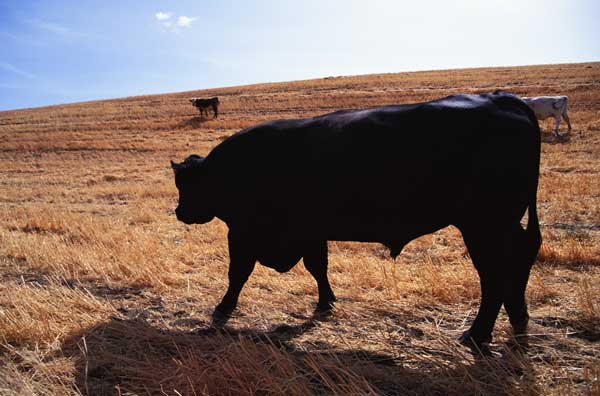
Cattlemen could make more money with heavyweight calves or stockers
Texas AgriLife researcher says 30 years of data show how heavyweight calves can pay.Most livestock producers in East Texas and the southeastern U.S. have stuck to cow/calf operations.Success of heavier-weight strategy depends upon good climatic conditions for planting and establishing winter pastures in the fall and some hay stocks to carry over during cold and inclement weather typical during December and January.
January 12, 2012

This is the first in a series of monthly articles about maximizing profits in today's changing livestock economy. Future topics will include stocking rates for stockers on winter pastures and Tifton 85 Bermuda grass; cow/calf performance on ryegrass or clover pastures; and cow/calf performance on pastures having no added commercial nitrogen.
"Rain or shine, wet or dry, do you want to make more money from your cows next year?" asks a Texas AgriLife Research forage scientist.
"It's possible primarily as today's high-priced corn has changed the way feedlots are doing business," said Dr. Monte Rouquette, AgriLife Research forage scientist.
Traditionally, most livestock producers in East Texas and the southeastern U.S. have stuck to cow/calf operations, Rouquette said. In the past, calves were weaned at 350 to 450 pounds and then moved directly to feedlots for finishing. Part of this traditional calf-management strategy has to do with the price of corn used in feedlot rations.
"Years ago, when it appeared as if $2 bushel corn was going to be here forever, the feeders developed animal health programs to allow them to secure lightweight calves and place these calves directly into the feedlot at weaning," he said. "These lightweight calves would remain in the feedlot for more than 250 days!"
But corn prices have increased "dramatically" in the last few years, in part due to ethanol production, and have rocketed to as high as $8 per bushel a few weeks ago. Prices came down in January, but were still in the $5 to $6 range. The response of the feeders has been to seek heavier-weight cattle for entry into feedlots, he said. For the livestock producer, "heavier-weight" cattle can mean just weaning calves later for a couple of hundred extra pounds or placing weaned calves on pastures for three to six months to increase weight and maturity. These longer-maintained cattle are commonly referred to as stockers.
These management strategies spell opportunity for livestock producers to make higher profits from their cattle herd by producing the heavier cattle the feedlots now prefer. "There are two primary strategies for selling heavyweight cattle," Rouquette said. "You can wean heavier-weight calves and maintain or purchase light-weight calves and place them on a stocker-grazing program, or do a mixture of both."
Rouquette noted that the Texas AgriLife Research and Extension Center at Overton, where he is based, has 30 years of data on the "pasture and animal interaction" to show what does and does not work under East Texas and southeastern U.S. climatic conditions.
Since the inception of the Texas AgriLife Research and Extension Center in 1967, one of the fundamental emphases has been forage management and animal performance, said Dr. Charles Long, resident director of research at the center.
"First, heavyweight calves at weaning are produced primarily from cows that calve during the fall to winter period -- and not during the late spring to early summer period," Rouquette said. This is because fall and/or winter-calving cows have access to winter annual pasture -- small grain, ryegrass, clover -- to provide the highest nutritive value possible for average daily gain to be high for the calves. It's not unusual for fall calves to wean at more than 700 pounds by early June, he said.
Climate is a factor
Rouquette noted that success of this heavier-weight strategy depends upon good climatic conditions for planting and establishing winter pastures in the fall and some hay stocks to carry over during cold and inclement weather typical during December and January.
Another strategy is to retain or purchase lightweight calves born in late spring to early summer and weaned in the fall, he said. "In this case, the best strategy is to prepare pastures that include small grain plus ryegrass," he said. "These are the forages that are the highest in dry matter and nutritive value for stockers and the only forages that are actively growing during the winter months in areas east of I-35 to Georgia and other parts of the southeastern U.S.
"Another management scenario involves those who have lighter-weight calves, from 400 to 500 pounds in May," Rouquette said. "They can turn these calves onto pastures such as Tifton 85 or other high-quality Bermuda grass pastures, or onto summer annual forages." He noted that one problem with this last strategy is that cattle performance in terms of average daily gain during July-August often declines because the nutritive value of warm-season grasses declines and high summer temperatures stress cattle.
"Of course, if we have another summer of drought like in 2011, then there has to be an alternative strategy," Rouquette said. "But keeping the possibility open of holding onto calves longer or buying calves for stockers if there is rain and good forage availability means opportunity for producers to make more money this year."
Rouquette emphasized the markets always have the trump card in management scenarios. "The price paid for 400- to 600-pound calves in 2012 could make it beneficial to sell them at that weight," he said. "The idea is to remain flexible and ready to adjust to changing conditions, including markets, and not to be locked into one stocking strategy or another. With a strategic management plan, one can decide to wean early, wean late, wean and sell, wean and retain and so on.
"For 40 years, Monte has conducted one of the longest, continuous series of studies evaluating productivity, persistence and quality of forage varieties and related cattle performance," Long said. In-depth information on these studies can be found at http://overton.tamu.edu/center-publications.
You May Also Like



